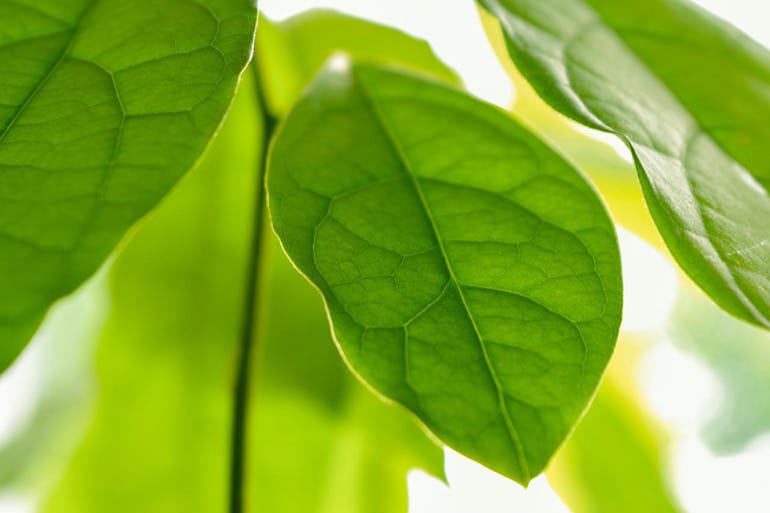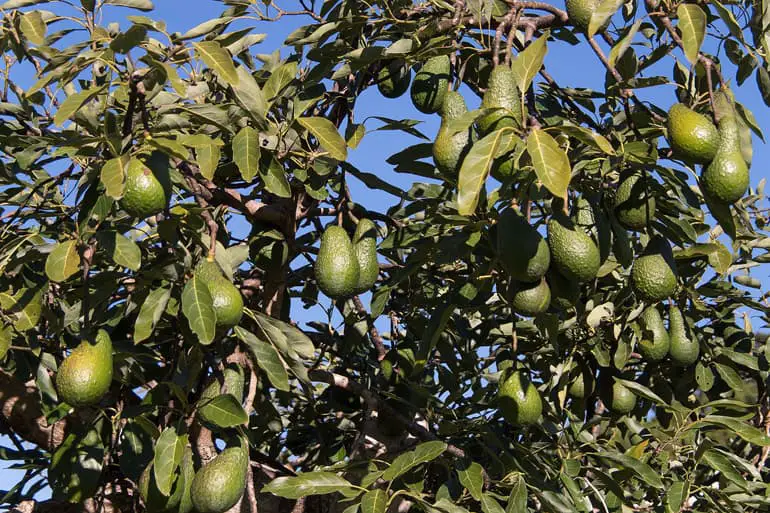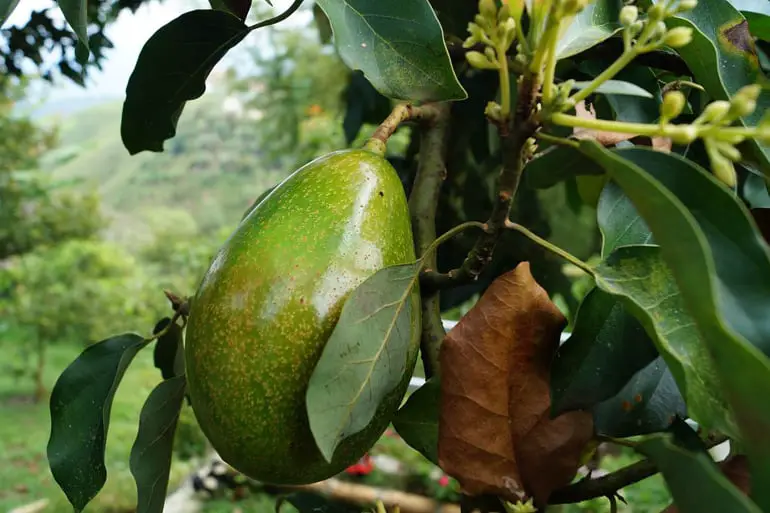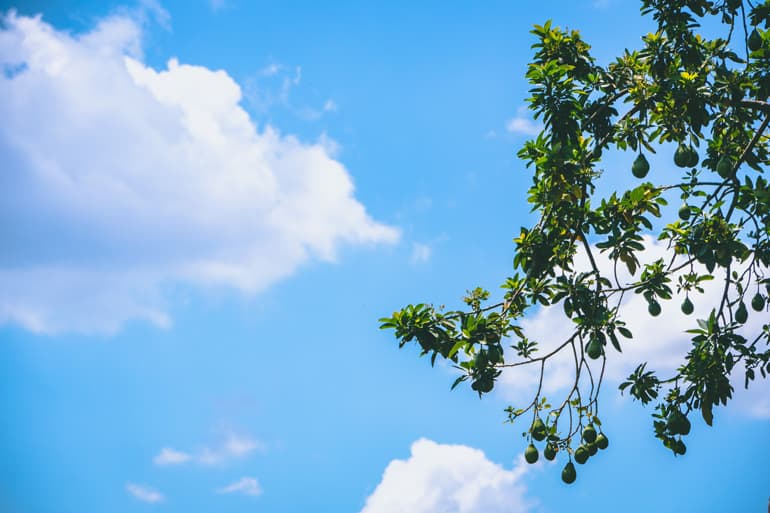Table of Contents
The Avocado tree, also popularly known as the alligator pear is an evergreen plant from the Lauraceae family. The tree is native to the Western hemisphere (Mexico south and Andean region) where it is used to serve many purposes. The edible fruits of Avocado are either used as toppings in food recipes like tacos, salad, guacamole, or eaten as dessert and can be readily identified with their greenish or yellowish skin and rich nutty flavor.

However, in the Bonsai world, the Avocado tree is not considered an ideal tree for Bonsai specimens even though the tree grows pretty fast and is very easy to raise. The leaves of the tree are considered to be too large and not likely to make a good specimen. Despite this, a skilled and dedicated Gardner can still make a beautiful Bonsai from an Avocado tree. Here, you will learn all the information required to successfully grow an Avocado plant Bonsai, as well as some secret facts about the tree.
General information
| Common name | Avocado |
| Scientific name | Persea americana |
| Family | Laurels |
| Height | 7ft tall as a Bonsai, up to 30fts as a landscape tree |
| Spread | 10 to 18 |
| Bloom time | March to May |
| Leaf | Evergreen |
| Fruit | Showy |
| Hardiness | Zones 9 to 11 |
| Maintenance | Low |
| Temperature | 60 to 85°F |
| Water | Moderate |
| Soil | A blend of sandy soil and compost |
Can I Bonsai an Avocado plant?
Yes, you can Bonsai an Avocado plant. The Avocado plant is known for its nutritional, multifunctional, and delectable taste, and if you would love to grow this lovely plant in your home without taking up too much space, you can grow the Avocado tree as either an indoor or outdoor Bonsai tree.
However, there has been a raging controversy as regards whether the tree will make an excellent Bonsai or not due to its naturally large leaves. Ideally, this should be a cause for concern, but this can be avoided by making use of Avocado species with small leaves or by ensuring that the tree is adequately trimmed.
Is the Avocado tree easy to Bonsai?
Yes, it is very easy to train Avocado trees as Bonsai specimens. Avocado is a fast grower and can grow up to 30 inches a year which means you will start to see results in no time. However, because some Avocado has large leaves, you might have to take pruning seriously even while the tree is at a very young stage.
Avocado plant Bonsai history

The Avocado plant (Persia americana) is originally from South-central Mexico and the tree is believed to have been in existence between 5000 to 7000 B.C. However, it takes several years before this popular Avocado species became widely cultivated around the world.
In a more recent time, Archaeologists from Peru discovered some local Avocado seeds that were buried with Incan mummies believed to have been entombed since 750 B.C. Also, there are some historical claims that people have been cultivating avocados in Mexico since about 500 B.C.
Avocado Bonsai scientific name

The scientific name of Avocado is Persea Americana
Do Avocado plants like the full sun?

Yes, Avocado plants like the full sun. Avocado trees, especially the Haas Avocado love to bask in direct, bright, and full sunlight. For your Avocado Bonsai to thrive, it needs to be placed in a position where it can be exposed to at least 6 hours of sunlight per day. Although, Avocado van tolerate partial shade to some extent, however, the more light they get, the better.
How long do Avocado plants take to fruit?
One interesting fact about the Avocado bonsai is that even though the tree is considered to be a fast grower, you will still have to exercise patience because most times you may have to wait for at least 3 to 4 years before your Avocado tree can start to bear fruit. Although this also depends on the method of propagation adopted.
If your Avocado Bonsai tree is propagated by cuttings, it should bear fruit between 3 to 4 years. However, if it is propagated by seed, your Avocado Bonsai should start fruiting in 13 years or more.
Avocado plant Bonsai care
For your Avocado plant to be successfully cultivated according to Bonsai tradition, you have to keep up with its care requirements. Without the knowledge of these care requirements, your tree will not germinate or grow to be an unhealthy plant and eventually die. Therefore, to avoid these ugly situations, you are advised to read the carefully explained care requirements in subsequent sections.
Avocado Bonsai temperature
Although the Avocado tree species in general are flexible in their demand for the weather (they love the sun and can tolerate cold), however, it is advisable to protect your tree from being exposed to temperatures below 30°F. Even though they can tolerate temperature levels between 30 to 32°, the ideal temperature level for Avocado Bonsai is 60 to 85°F.
Avocado Bonsai fertilizer
The most important nutrient required for an Avocado to grow healthily is Nitrogen, therefore, you should feed your Avocado Bonsai with a fertilizer that is rich in Nitrogen and a little bit of zinc. The good news is you can also feed your Avocado tree with citrus tree fertilizers. Or you can go completely organic by using coffee, fish emulsion, or compost.
Avocado Bonsai pruning
You need to prune back your Avocado Bonsai as it grows to encourage branching. Pruning your Avocado tree will keep them short and normal and also make the trunk grow stronger. For avocados, pruning is essentially important because they have large leaves which can be as long as 10 inches long in some or longer in some others. Prune your Avocado tree once or twice a year once you start to notice new growths on the tree.
Avocado Bonsai repotting
The best time to repot your Avocado Bonsai is mid-spring and this should be done every year in the first 3 years. Once the tree attains ages 4, 5, and more, report it every 2 years. Use an appropriately sized pot with drainage holes and a porting mix with cactus and succulent label.
Avocado Bonsai pest and disease
Avocado produces tasty fruits and will make an excellent addition to your Bonsai collection. However, one of the setbacks often confronted by lovers of the trees is insects and pests that attack and sabotage the healthy growth of the tree. Here, details will be provided about these diseases and pests as well as suggestions on how their growths can be curtailed.
1. Cankers
Although, compared to other diseases that attack Avocado tree, cankers is seen as a minor disease, however, on some cases the damages caused as a result of its infestation can be fatal.
Cankers are visible sores that appear on Avocado trees and trunks. These sores can ooze gum and sink slightly into the tree branches causing rusty appearances. You can easily get rid of canker infestation by cutting it out of the tree limb however, cankers in the tree trunk can kill affected trees and would require more aggressive attention.
2. Fruit rot
Fruit rot is caused majorly by Fungal pathogens and this occurs mostly when there’s no proper sanitization or when you heavily stress your Avocado tree. These fungi hibernate in plant debris laying on the ground near the tree or in fruits that we’re left behind after harvesting. You can easily curb their spread by pruning your Avocado tree as required and prompt removal of fruits.
3. Sunblotch
Sunblotch is one of the major diseases common to the Avacado tree and this is because in most cases the damage caused is uncurable.
Sunblotch often causes discoloration of leaves or scarred twigs or rectangular cracks on the tree bark. The effect of sunblotch on some avocado trees may include low yield or stunted growth. You can control sunblotch by making use of certified disease-free stock and stopping the spread by ensuring to sanitize your tools after use.
4. Lace bugs
Although lace bug infestation is not something you see often on Avocado trees, when they appear, they damage leaves. You can identify their infestation with yellow spots on leaves and naked woods as a result of the shedding of stressed leaves which exposes wood and fruits to UV light. You can treat Lace bug infestation by applying horticulture oil or pyrethrin on affected trees.
Avocado Bonsai soil
It is best to plant your Avocado Bonsai tree in horticultural sand to ensure proper drainage and also give the tree a firm grip especially when they are large. You can also make use of sandy soil, but to get the best out of the soil, you might need to properly mix it with organic matters like compost before planting your tree in them.
Avocado watering
Your Avocado tree will require watering right from the very first day of planting. Water them on the first day of planting and skip every second day for the first week after planting. Reduce watering afterward to just once or twice per week for several months to come.
During seasons with little rainfall, thoroughly water your Avocado tree 2 times a week if it is less than 3 years old. At the early stage of your tree, it is best to water close to the tree trunk, however, as the tree matures, it would be better to water far away from the trunk.
Water your Avocado tree regularly during dry seasons as they would benefit more from it. And during hot summer, make sure to give your tree at least 2 inches of water per week. It is also important to always keep your matured Avocado tree stays at least moderately wet from the bloom period of the tree till the fruit ripens.
Avocado Bonsai sun requirement
Avocado trees require enough sunlight to germinate and therefore, you must endure placing your Avocado tree in a place where it can be exposed to full sunlight for at least 6 hours a day.
Avocado Bonsai winter care
For the young Avocado Bonsai tree, cover it with a blanket to cloth and also wrap the trunk to protect it from cold during winter. For matured avocados, it will be difficult to cover or wrap their trunk up with a blanket, therefore, the best way to protect your matured Avocado during winter is by ensuring proper irrigation when the frost event becomes imminent.
Avocado Bonsai on rock
Interestingly, you can grow Avocado Bonsai on the rock. However, growing Avocado pm rock is not a simple project that can be embarked on except you are an expert because it takes time and requires lots of attention to pull off.
Do Avocado plants like acidic soil?
Yes, avocados like acidic soil. Although Avocado tree favors soil with high pH levels and grows best in soil with pH levels within the range of 5.8 to 6.3. You can keep the calcium level of your Avocado tree high without raising the pH by adding Gypsum to the soil.
Do Avocado trees like to be misted?
Yes, Avocado likes to be misted. Avocado is a water-loving plant and enjoys being watered regularly as long as it is not excessively wet. Avocado is vulnerable to root rot and therefore it is advisable to keep the root dry. However, while the root benefits more from staying dry, Avocado leaves love humidity. Hence, it will be beneficial to mist your Avocado Bonsai leaves daily with water.
Can you grow an Avocado plant indoors?
Yes, you can grow your Avocado Bonsai as an indoor plant in any planting zone.
Can you take cuttings from Avocado?
Yes, you can take cuttings from Avocado. Avocado plants can be propagated either by seed, cuttings, grafting, or layering. Of all these methods, propagation by cuttings is considered the best because the resulting tree will be a replica of the parent tree.
How to grow Avocado Bonsai from seed
- Plant the seeds in a container with well-draining soil
- Place the container in a shady spot with no direct sunlight.
- Water the seeds regularly and ensure it is properly fertilized every month.
- Prune dead leaves and branches as required.
How to prune an Avocado Bonsai tree
It is best to prune your Avocado tree with sterile scissors, check below for information on how to sterilize your scissors and how they can be applied.
- Make a solution from the mixtures of 9 parts of water, and 1 part of bleach.
- Dip your pruning scissors in the solution and leave it soaked for about 5 minutes.
- Trim the leaves to shape using the scissors and prune the beaches as well.
How big is the Avocado tree Bonsai?
The avocado tree can grow as tall as 40fts high and its leaves can reach up to 10 inches long.
How to keep the Avocado tree small
Avocado trees can grow pretty tall and the only way they can be kept short is by pruning them. Prune your Avocado Bonsai at least once every year to keep it short and in shape.
How long does it take for an Avocado plant to sprout?
If you plant your Avocado tres from seed, it will take 5 to 13 years before it can bear fruit but it will take the seed between 2 to 6 weeks to germinate.
Can you trim the top of an Avocado tree?
Yes, you can trim the top of the Avocado tree. Once your Avocado tree reaches about 12 inches tall, snip off the top of the tree so that its height can be reduced to about 6 inches. Leave the tree to reach its original height before you trim it again. This will encourage the tree to develop lateral branches.
Why is my Avocado plant Bonsai droopy?
Your Avocado plant is likely to have droopy leaves if it is being under or over water, but mostly under-watering is believed to be the major cause.
To trace the cause of your droopy Avocado leave, dip your finger 2 to 4 inches deep into the soil to test its moisture level. If the soil feels dry, water the soil is needed without getting it soaked. On the other hand, if the soil is wet, do not water it until it is dry but not for a long time.
Are Avocado leaves poisonous to cats?
Yes, Avocado leaves are poisonous to cats. The leaves of Avocado are toxic to cats and are even considered to be more toxic compared to the fruit therefore, it is often suggested to always keep your Avocado houseplant away from the reach of your cat. If at all you want to give Avocado to your cat to eat, give them just a slice of the flesh.
Why does Avocado Bonsai have brown leaves?
There are 2 major causes of brown leaves – sun scorch and dry air.
If you are cultivating your Avocado tree Bonsai as an indoor plant, it must not be kept in a place with very low humidity. Low humidity causes dey air and when your Avocado tree is exposed to such conditions, the leaves of your tree will start to have brown edges.
Another cause of brown leaves on your Avocado plant is sunburn. If you are originally raising your Avocado plant as an indoor plant, then you suddenly relocate it outside, and your tree may suffer sun-scorch which may cause brown discoloration on the leaves of your tree.
![Pittosporum Bonsai [Pittosporum Tobira]](https://www.bonsai-express.com/wp-content/uploads/2022/05/Pittosporum-Bonsai-365x200.jpg)
![Sorbus Bonsai [Sorbus Aucuparia]](https://www.bonsai-express.com/wp-content/uploads/2022/05/Sorbus-Bonsai-365x200.jpg)
![Tsuga Bonsai [Tsuga Canadensis]](https://www.bonsai-express.com/wp-content/uploads/2022/05/Tsuga-Bonsai-365x200.jpg)
![Tamarix Bonsai [Tamarix Ramosissima]](https://www.bonsai-express.com/wp-content/uploads/2022/05/Tamarix-Bonsai-365x200.jpg)